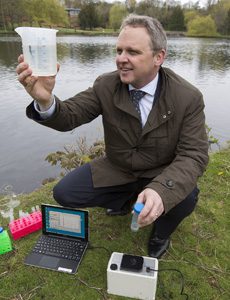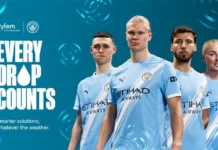
Experts at the University of Birmingham have developed a “unique” device that could save lives around the globe by quickly and simply testing whether water supplies are safe to drink – particularly in refugee camps and disaster zones.
A team from the University’s Department of Civil Engineering has developed prototype optical equipment which uses water’s natural fluorescence to ‘scan’ the water and highlight pollutants that are present in the sample – almost instantly revealing whether supplies are safe to drink.
The researchers are now working with experts from Oxfam and funding from the Engineering and Physical Sciences Research Council and the Diageo Foundation to refine the instrument design and make it ideally suited to disaster relief and areas of poor sanitation.
The ‘Duo Fluor’ device uses portable and inexpensive, off-the-shelf equipment to reveal unsafe sources of drinking water in less than 30 seconds. It should help reduce the risk of future widespread outbreaks of cholera and other water-related diseases in areas of poor sanitation.
Professor John Bridgeman led the team of researchers who developed the device. He said: “The ‘Duo Fluor’ device is a huge step forward in managing water and wastewater systems and has the potential to save lives around the globe – particularly in refugee camps and disaster zones, where it is vital to ensure that people have access to safe water supplies.
“Microbiological waterborne disease remains a significant concern for the global water community. Pathogens in drinking water sources cause ill health and disaster relief scenarios, in particular, require rapid drinking water quality checks to prevent the spread of disease and death.”
He added that despite the hard work of those responding to the UN Millennium Development Goals, there are still 768 million people who do not have access to safe drinking water supplies and 2.5 billion are without access to improved sanitation services.
Current methods of analysing the quality of drinking water take more than 12 hours and use expensive reagents. This is not fast enough to meet people’s needs in disaster zones and poor communities.
“Duo Fluor allows water experts to interpret results, but also uses user-friendly technology to allow non-experts to test whether water is safe to drink,” said Professor Bridgeman. “This means that people in the poorest communities could help to protect themselves from unsafe drinking water.”
The instrument has a range of potential uses within the global water industry, including:
Detecting organic and microbial matter in a range of water qualities – from sewage to drinking water;
Improving process efficiency at water treatment works;
Identifying potential contamination of service reservoirs and distribution systems; and
Testing river water quality at abstraction points and treatment works’ discharge points.






